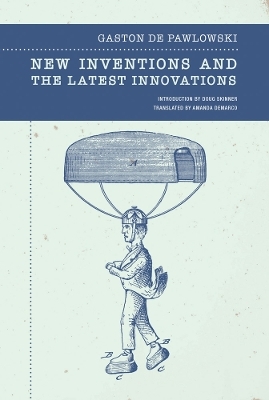
New Inventions and the Latest Innovations
Seiten
2024
Wakefield Press (Verlag)
978-1-939663-98-6 (ISBN)
Wakefield Press (Verlag)
978-1-939663-98-6 (ISBN)
Satirical yet prophetical advertisements for imaginary new products, influential to Marcel Duchamp and Francis Picabia
Originally published in book form in 1916, this volume of French author Gaston de Pawlowski’s (1874–1933) writings, New Inventions and the Latest Innovations, collects the humorist’s fictional columns mocking his era’s burgeoning consumerism and growing faith in science. From anti-slip soap, gut rests and the pocket-sized yardstick to repurposed spittoons, nasal vacuums, electric oysters and musicographical revolvers, Pawlowski offers a far-sighted critique of technological gadgetry and a cynical promise to remove discomfort from every facet of life, even as World War I raged on and technology was unleashing new horrors onto humanity.
Pawlowski’s humorous cultural critique and tongue-in-cheek celebration of uselessness and futility bears relevance for today, as technology remains the hoped-for answer to our increasingly troubled human condition. Described with the excessive optimism of the sales pitch, these inventions of yesteryear were also an influence in the arts, admired by such figures as Marcel Duchamp and Raymond Queneau, and standing as a precursor to the work of such artists as Jean Tinguely and today’s looming specter of AI-generated artwork and literature.
Originally published in book form in 1916, this volume of French author Gaston de Pawlowski’s (1874–1933) writings, New Inventions and the Latest Innovations, collects the humorist’s fictional columns mocking his era’s burgeoning consumerism and growing faith in science. From anti-slip soap, gut rests and the pocket-sized yardstick to repurposed spittoons, nasal vacuums, electric oysters and musicographical revolvers, Pawlowski offers a far-sighted critique of technological gadgetry and a cynical promise to remove discomfort from every facet of life, even as World War I raged on and technology was unleashing new horrors onto humanity.
Pawlowski’s humorous cultural critique and tongue-in-cheek celebration of uselessness and futility bears relevance for today, as technology remains the hoped-for answer to our increasingly troubled human condition. Described with the excessive optimism of the sales pitch, these inventions of yesteryear were also an influence in the arts, admired by such figures as Marcel Duchamp and Raymond Queneau, and standing as a precursor to the work of such artists as Jean Tinguely and today’s looming specter of AI-generated artwork and literature.
| Erscheinungsdatum | 18.07.2024 |
|---|---|
| Einführung | Doug Skinner |
| Übersetzer | Amanda DeMarco |
| Verlagsort | Cambridge |
| Sprache | englisch |
| Maße | 133 x 203 mm |
| Themenwelt | Literatur ► Essays / Feuilleton |
| ISBN-10 | 1-939663-98-9 / 1939663989 |
| ISBN-13 | 978-1-939663-98-6 / 9781939663986 |
| Zustand | Neuware |
| Haben Sie eine Frage zum Produkt? |
Mehr entdecken
aus dem Bereich
aus dem Bereich
so erkennst du dein wahres Ich
Buch | Hardcover (2024)
Piper (Verlag)
18,00 €
vom Zustand der Debatte in der Digitalmoderne
Buch | Hardcover (2023)
Kiepenheuer & Witsch (Verlag)
22,00 €
die dunkle Geschichte der reichsten deutschen Unternehmerdynastien
Buch | Softcover (2024)
Kiepenheuer & Witsch (Verlag)
16,00 €


